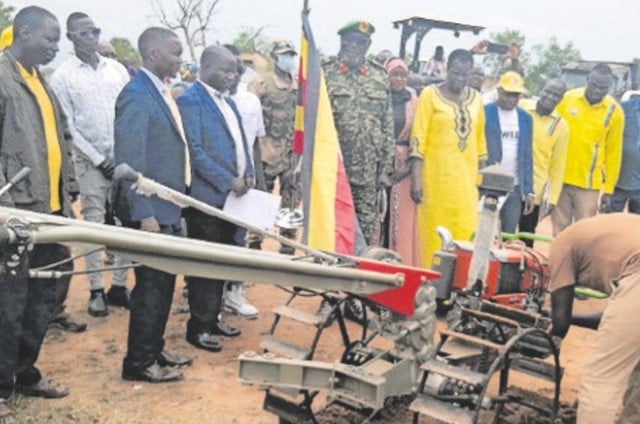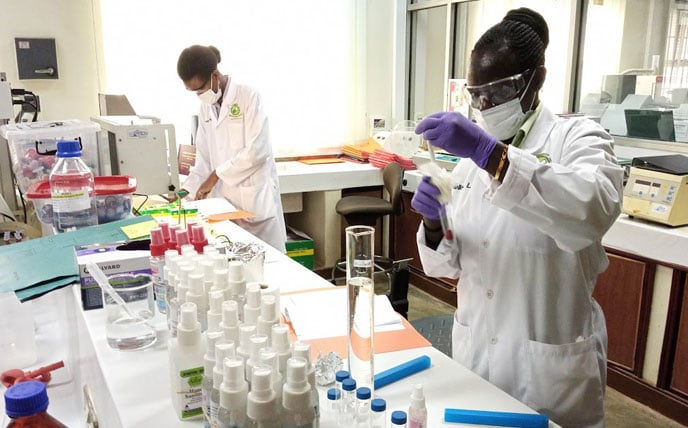Why 2-wheel tractors failed to transform farmers' livelihoods

A technician demonstrates how to operate the two-wheel tractor to Pakwach District leaders in February. PHOTO | PATRICK OKABA
What you need to know:
- Farmers are calling for better support, including timely delivery of spare parts, extensive training, and more reliable machinery to help them transition from manual labour to mechanised farming
In 2021, Ms Grace Adaku, a long-time user of the traditional handheld hoe, saw her dreams realised when her local farming group received a two-wheel tractor, provided by the Ministry of Agriculture, Animal Husbandry, and Fisheries.
These two-wheel tractors were part of a government initiative to boost agricultural productivity, enabling farmers to cultivate more land, reduce the time spent tilling, and promote commercial farming. However, Adaku’s excitement was short-lived.
Within three months, the machine broke down, forcing her back to using the labour-intensive hoe. Adaku said: “We did not use it for long because it broke down just after three months. This is why I am now back to using the hoe, which consumes a lot of my energy.”
The story of Adaku is not unique. A closer examination by the Monitor into the two-wheel tractor initiative across West Nile reveals widespread abandonment of these ma- chines. Many farmers attribute this to lack of operational skills, missing parts, and mechanical failures.
Adaku lamented that the hand-held hoe could not lift them out of poverty and appealed to the government to revamp the two-wheel tractor project or upgrade them to four-wheel tractors and make them affordable for hire. Two-wheel tractors are multi-purpose and can carry out digging, slashing and with provisions of irrigation. Most of them consume about 0.8 litres of diesel in one hour.
In Yumbe District, Mr Paul Adiga, the chairperson of Abara Cassava Processing and Marketing Farmers group in Odravu sub-county, said: ‘’We received the tractor for our group with some key parts missing such as the pin. The pin is the part of the tractor that is used to hold the plough and without it, the tractor cannot work.’’
He said during training, they were assured that the spare parts would be availed but nothing has been done to address the matter. Ms Rahima Driwaru, a farmer in Kulikulinga Town Council, said the person operating the tractor went to Juba in South Sudan.
“Our tractor is not down but it is non-functional in the absence of the operator. During the training, only one person from our group was trained. This is giving us a hard time because some of the group members don’t know how to operate the tractor,’’ she said.
She said they plan to either hire a new operator or train more group members on how to operate it. Not all is lost Not all experiences with two-wheel tractors have been negative. Mr Mizamil Okuma, a farmer from Kululu Sub-county, said his group has managed to cultivate 22 acres using their two-wheel tractor.
While acknowledging the manual nature of the machine, he noted that it works better than ox-ploughs in terms of speed and depth of digging. “It needs three to four well-fed operators to be able to cultivate two acres of land for a full-day service. It works better than the ox-plough because it digs deeper and the speed is good when gear number two and three are used,” he said.
However, he added that many people are reluctant to use the machine, as they expect it to function like conventional tractors and are dissatisfied with its limitations.
“For our case in Ewafa Cassava Processing and Marketing Farmer’s group in Kululu Sub-county, we have so far opened 22 acres of land since the tractor was given to us,’’ he added. Response Mr Rashid Kawawa, the district production officer for Yumbe, confirmed that 26 tractors, both two-wheel and four-wheel, were distributed to various farmer groups. He, however, acknowledged that missing parts, such as clutch cables, batteries, and ploughs, have rendered many of them non-functional.
“There are some groups that have failed to operate the tractors because of inadequate training. So, there is a need for more training on how to operate the tractors. We have written to the ministry about the missing parts of the tractors but they promised that the missing parts will be brought,’’ he added.
The district production officer of Obongi, Mr Johnson Opigo, said the district received six two-wheel tractors that were distributed to six sub-counties but have remained idle. “Majority of the farmers’ groups we have given the tractors are complaining that the tractors are hard to operate and require a lot of energy, calling them a death trap,” Mr Opigo said.
Mr Benjamin Afekuru, the tractor operator for Palorinya acknowledged having parked the tractor due to the difficulty in operating the machine.
“We started well, we opened 10 acres when there was rain, but when the rain stopped, we found it difficult to use the tractor. I think there is a need to remodify the tractors for it to be user-friendly,”Afekuru said.
Mr Abdula Asiki, the chairperson of the farmers group in Obongi Town Council, also said the tractor lacks some essential parts. The situation is similar in Adjum- ani District, where many of them have been abandoned at the production department since they were delivered. The district production officer, Dr James Mamawi, said they received 11 tractors and distributed them.
“We gave out the machines im- mediately. Some farmers are us- ing them. This has helped farmers increase their acreage since most of them were using hand hoes,” Mamawi said.
Reported by Felix Warom Okello, Robert Elema and Marko Taibot




